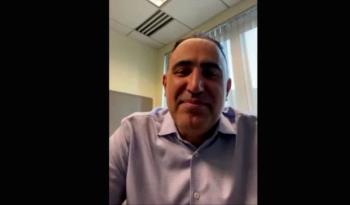
Implications of the IKEMA Interim Analysis
Expert physicians consider the practical implications of the IKEMA interim analysis of isatuximab plus carfilzomib and dexamethasone versus carfilzomib and dexamethasone in relapsed/refractory multiple myeloma.
Episodes in this series

C. Ola Landgren, MD, PhD: When we talk about switching different IMiDS [immunomodulatory imide drugs] we have had for many years, in 2006 lenalidomide and pomalidomide were FDA approved for myeloma. In more recent times we have had another antibody approved. Daratumumab was approved in November 2015, and in 2020 we had isatuximab approved. At ASH [American Society of Hematology Annual Meeting] we heard about the isatuximab with carfilzomib and dexamethasone. It’s not DKd [daratumumab, carfilzomib, dexamethasone]. It’s IKd [isatuximab, carfilzomib, dexamethasone] or isatuximab–Kd [carfilzomib, dexamethasone] vs Kd [carfilzomib, dexamethasone]. This is the IKEMA study, which is very similar to the CANDOR study. It used the same carfilzomib at 56 mg/m2 (20 mg/m2 twice a week) in the control arm—carfilzomib 56 mg/m2 with DEX [dexamethasone].
Ajai, what are the implications of this study and the findings? Do you practice across the board?
Ajai Chari, MD: Yes, it’s another favorable study. Hazard ratio was 0.53 favoring the addition of isa [isatuximab]. It was notable that actually fewer patients discontinued for toxicity with the addition of isa [isatuximab] relative to the control arm.
Regarding the safety of adding a CD38 to the Kd [carfilzomib, dexamethasone] backbone, the main challenge is in terms of a triplet, a reimbursement done in the subcutaneous formulation of DARA [daratumumab] vs the IV [intravenous] formulation of isa [isatuximab]. I still think they’re comparable. I’m not convinced that if somebody is refractory to frontline DARA [daratumumab], I would necessarily use isa [isatuximab] with that patient. I haven’t seen compelling data; I probably would switch that out. Certainly if somebody is naïve to CD38, isa-Kd [isatuximab, carfilzomib, dexamethasone] is doable.
C. Ola Landgren, MD, PhD: The control arm, Kd [carfilzomib, dexamethasone] 56 mg/m2, was the same in CANDOR and IKEMA. If you just look at the control arm, PFS [progression-free survival] was in 2 studies. The IKEMA control arm is probably statistically a better outcome compared with the CANDOR control arm. I have not done the statistical tests myself, I’m just eyeballing. The PFS is better, so presumably it’s the less sick population. Then you talk about the hazard ratio. And you didn’t mention this, but the PFS was better for the isatuximab–Kd [carfilzomib, dexamethasone] vs DARA-Kd [daratumumab, carfilzomib, dexamethasone] in the CANDOR study. Most likely for the same reasons. With this cross-study comparison, we have to put on cautious hats when we look at the studies, right?
Ajai Chari, MD: That’s why I didn’t do it.
C. Ola Landgren, MD, PhD: Rafael, have you been using rituximab, or are you still using DARA [daratumumab]? Or do you do both?
Rafael Fonseca, MD: Our predominant practice remains for daratumumab because of the subcutaneous administration—the convenient aspect for patients. It’s fair to say that IKEMA was a very powerful study.
I ask myself, under what circumstances is this likely to gain traction in the clinic? One possibility might be the pharmacoeconomics perspective. That’s more for the commercial teams, especially for pill systems, to decide how they can play out. It’s really hard to overcome the factor of the subcutaneous convenience for administration.
As you stated, in this trial, this is why I remain puzzled. In this trial, the medium PFS was not reached for the isa-Kd [isatuximab, carfilzomib, dexamethasone]. Their results look good; there’s still some censoring going on. I can see how this could play a significant role in better treatment for patients with myeloma.
We have to see some empirical data of this direct comparison of the 2 antibodies. We saw some data, but we have to see more data on what happens if you’re previously exposed to DARA [daratumumab] and then you take isa [isatuximab], or vice versa. It’s pretty early to say how that’s going to work out. Those would be my key takeaways from this particular study.
Ajai Chari, MD: Rafael, you reminded me of the pharmacoeconomic and convenience perspectives. Another difference between the 2 is that in the long term, the subcutaneous DARA [daratumumab] is once monthly vs the isa [isatuximab] every 2 weeks. That’s another consideration for convenience and pharmacoeconomics.
C. Ola Landgren, MD, PhD: To be very practical here, when we talk about convenience, for DARA [daratumumab] subcutaneous in my practice you would give the injection. We would keep the patients for about 4 hours the first time and then let them go. If nothing happens, which is usually 9 of 10 patients, for the next dose it’s a quite simple injection; then bye-bye. It’s a very quick mission. But for isatuximab it is a 2-hour intravenous infusion every time, right? That’s what we’re talking about.
Rafael Fonseca, MD: There are more rapid infusion protocols. The other thing is also that difference becomes more important if you have a parenteral drug—if you have an oral drug partner for isa [isatuximab]—right? If you’re getting carfilzomib there and you’re getting your IV, then as Rafael pointed out, the pharmacoeconomics may make this the big decision.
C. Ola Landgren, MD, PhD: But carfilzomib is a half-hour infusion.
Ajai Chari, MD: No question. It’s not like you’re keeping somebody hostage when they’re going to go home and take pomalidomide, right?
C. Ola Landgren, MD, PhD: That’s absolutely true. It’s not 5 vs 10 minutes, it’s 5 minutes vs more minutes. We know on an IV drug the patient has to sit down, and the drug has to be put on the device. There are many practical tests before you hook up the IV; it adds up to a lot of minutes for the patient.
Newsletter
Stay ahead of policy, cost, and value—subscribe to AJMC for expert insights at the intersection of clinical care and health economics.



















































